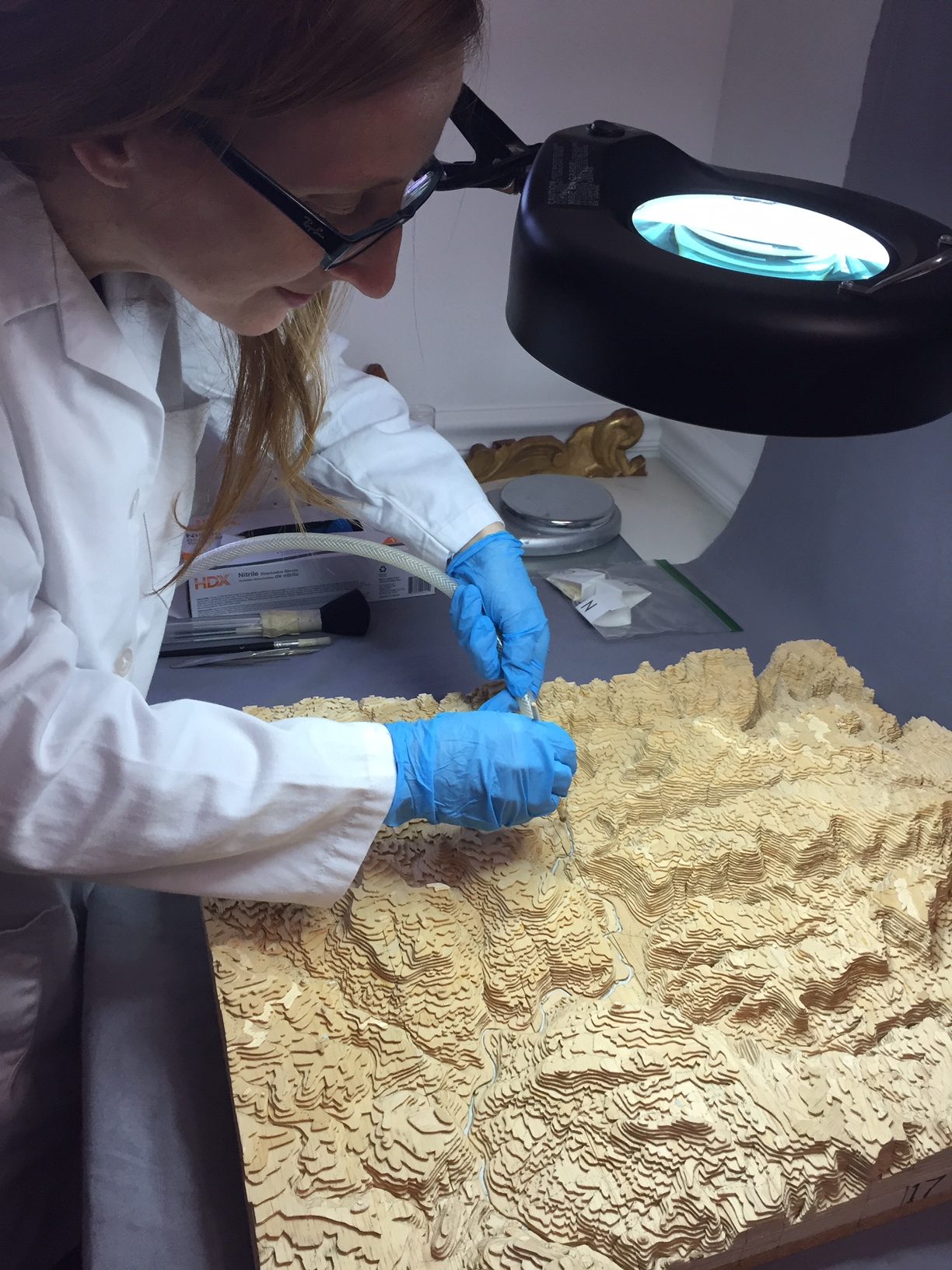Some information may be outdated.
“Everyone who walks in the door these days goes, ‘Hey, whatever happened to that map?” said Mary Langworthy, membership and community outreach coordinator for the Moab Museum.
The map in question is a seven-square-foot geographic model of the Moab area, handcrafted from razor-cut balsa wood and based on the U.S. Geological Survey 7 .5 minute quadrangles map. After more than 15 years on display, the map has been temporarily removed from its public place in the museum to be evaluated and restored by a professional conservator.
“It’s super stunning,” Langworthy said. The map was painstakingly crafted by the late John Urbanek, who worked at Arches National Park and began building the map when he retired in 1985. The model covers the area bounded by the La Sal Mountains and Dead Horse Point State Park to the south and the Canyonlands Regional Airport and the confluence of the Dolores and Colorado rivers to the north.
Urbanek’s birds-eye vision of the landscape was informed by his time serving as a pilot during the Korean War before joining the Park Service. Over 20 years after undertaking the project, Urbanek completed the map and gifted it to the museum, where visitors could study and admire the intricate, three-dimensional miniature Moab.
The next event in the Tuesdays with the Museum series invites members of the public to learn more about the techniques being used to care for the map as well as the museum’s efforts to improve the management of their collection. Moab Museum Curator and Collections Manager Tara Baresh will talk with Kimberleigh Collins-Peynaud, a Salt Lake City-based art and object conservator tasked with restoring the map. Their conversation will be livestreamed on the museum’s Facebook page at 6:30 p.m. on Tuesday, March 2. Interested members of the public may also join the conversation via Zoom through a link on the museum’s website, www.moabmuseum.org.
“When Museum renovations were completed in March 2019, management and staff enacted a new approach to collections care—one aligned with the standards held by regional, accredited cultural institutions,” Beresh wrote in a Jan. 22 blog post on the museum’s website. Staff has been working diligently to collect data on objects in the museum’s collection, evaluate the condition of long-held items, and upgrade display and storage facilities and practices.
The museum’s planned re-opening in 2020 was postponed because of COVID-19, but Langworthy said the board and staff are using the extended closure to spend even more time caring for the collection.
“We’ve been trying to do some of the behind-the-scenes work,” she said. In the case of the Urbanek map, that work involves removing dust and other particles and grime from the delicate map using fine brushes and a HEPA-filtered vacuum with low-power suction to ensure gentle handling. Collins-Peynaud, who has restored sculptures and other objects for institutions around the world, is going through the map section by section.
In some places, small fragments of the map have broken off; Collins-Peynaud searches the tiny crevices to find shattered fragments and re-fits them as tightly as possible in their places. Where the map appears fragile, she is adding reinforcement to prevent future breakage. In inspecting the map, Collins-Peynaud has found debris and casings that indicate the presence of wood-eating bugs in some parts of the complex map.
“Were the map left untreated, other insects and pests might be attracted to feed on these particulates,” Baresh wrote. Mold is another concern, as is the possibility that dust particles could scratch the soft balsa wood.
“If treated in time, a sculpture like the Urbanek map can be restored to its like-new vibrancy,” Baresh said.
Collins-Peynaud praised the organization for its dedication to preserving the beloved map.
“I am filled with hope from witnessing the way the Moab Museum is taking care of their collections,” she told Baresh.
Langworthy agreed that it’s the museum’s responsibility to preserve an object like the Urbanek map.
“This is an important part of what museums should do to care for community treasures,” she said, adding that the process is surprisingly fascinating and “weirdly satisfying to watch.”
“This is one of the most fun projects ever,” she said, describing how as she watches Collins-Peynaud deep-clean the work, “I’m imagining I’m this tiny little hiker exploring all these canyons and mountains.”
At the Tuesdays with the Museum event, Collins-Peynaud will share time-lapse images that show the restoration of the map bit by bit and give a demonstration of cleaning techniques. She is more than halfway through the 21 sections of the map. Langworthy said she expects the restoration will be complete within the next couple of months. When it’s ready, the map will again be displayed for the public to enjoy. In the meantime, map-lovers can enjoy a virtual experience of the model this Tuesday.
“This is an important part of what museums should do to care for community treasures.”
– Mary Langworthy
When: Tuesday, March 2 at 6:30 p.m.
Where: Visit www.moabmuseum.org to find the Zoom link, or watch the livestream on the museum’s Facebook page
Cost: free
Appreciate the coverage? Help keep local news alive.
Chip in to support the Moab Sun News.





